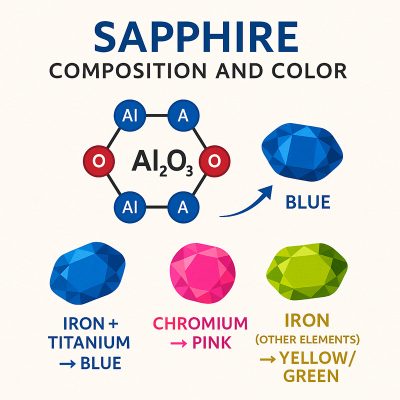Sapphires: Composition, Formation, and Origins
INTRODUCTION
Sapphires are one of the three precious colored gemstones. The others being Rubies and Emeralds. It is a variety of the mineral Corundum which is a mineral that includes both sapphires and rubies. Red corundum is known as ruby and all other colored corundum are known as sapphires with blue being the most common. Sapphires that are not blue are known as fancy sapphires and can occur in yellow, purple, orange, and green colors; “parti sapphires” show two or more colors. Sapphires are the single most versatile stone with so many color choices and a hardness only beaten by diamonds.
SAPPHIRES: COMPOSITION, FORMATION, AND ORIGINS
Chemically, sapphires are composed of aluminum oxide (Al₂O₃). What gives sapphires their stunning colors are trace elements that become incorporated into the crystal structure during formation.
For example:
Blue sapphires owe their color to the presence of iron and titanium.
Pink sapphires contain traces of chromium.
Yellow and green sapphires are influenced by a combination of iron and other elements.
Sapphires have a trigonal crystal system, forming hexagonal prismatic crystals. They are exceptionally hard, ranking 9 on the Mohs scale—just below diamonds—making them suitable for daily wear in all types of jewelry.
FORMATION OF SAPPHIRES
Chemically, sapphires are composed of aluminum oxide (Al₂O₃). What gives sapphires their stunning colors are trace elements that become incorporated into the crystal structure during formation.
For example:
Blue sapphires owe their color to the presence of iron and titanium.
Pink sapphires contain traces of chromium.
Yellow and green sapphires are influenced by a combination of iron and other elements.
Sapphires have a trigonal crystal system, forming hexagonal prismatic crystals. They are exceptionally hard, ranking 9 on the Mohs scale—just below diamonds—making them suitable for daily wear in all types of jewelry.

Key Pages: Create & Customize Jewelry
Key Pages: Diamond Jewley From the Atelier
Essential Diamond & Jewelry Education
Important Links: Support & Policies
MyAntwerpDiamonds.com /
Some email responses from us may be filtered as spam or blocked altogether. To ensure you receive our emails, please provide your telephone or WhatsApp number for verification.



